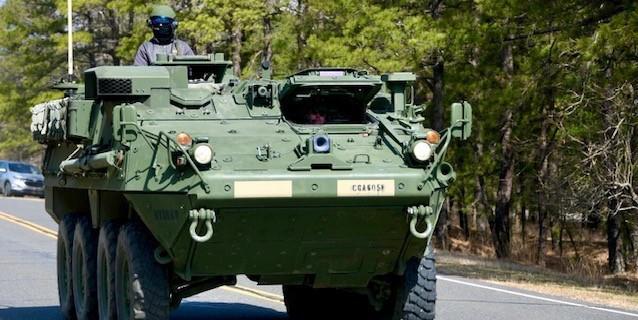Army Researchers: CMOSS Works
The U.S. Army for the first time has demonstrated during its Network Modernization Experiment the integration of three capability cards—one for positioning, navigation and timing, another for mounted mission command, and a third for the TSM tactical communications waveform. The capabilities are associated with the service’s open suite of standards and were integrated onto a Stryker combat vehicle.
The service also demonstrated air-to-ground and ground-to-ground interoperability with a UH-60 and Nett Warrior capabilities for the dismounted soldier. The ability to quickly change capability cards rapidly means the Army can modify vehicles for different mission types to meet emerging threats and improve mounted soldier lethality and survivability, according to a recent Army article.
The advance is part of the Army’s effort to develop a standard open standard architecture known as CMOSS, which stands for Command, Control, Communications, Computers, Cyber, Intelligence, Surveillance, Reconnaissance (C5ISR)/Electronic Warfare Modular Open Suite of Standards. CMOSS enables the Army to insert cards, each embedded with networked capabilities such as communications waveforms, mission command applications, and positioning, navigation and timing, into a common ruggedized chassis inside a tactical vehicle. It provides a plug-and-play alternative to custom-installing and upgrading individual communications systems and allows significant size, weight and power savings.
The CMOSS capability will be fielded with the Army’s network Capability Set 25 in 2025. The Network Modernization Experiment, commonly known as NetModX, is a field-based experiment run by engineers from the Army’s C5ISR Center.
L3 Harris, General Dynamics Mission Systems, Spectranetix, Trellisware, SRC Incorporated, Curtiss-Wright and Collins Aerospace demonstrated CMOSS products during the experiment. The systems included tactical communication capabilities and emerging waveforms, electronic warfare and data encryption capabilities, assured positioning, navigation and timing capabilities, and CMOSS infrastructure prototypes for hosting C5ISR capabilities.
“We brought to NetModX a CMOSS-based solution that integrates a Trellisware waveform communications solution along with a positioning, navigation and timing solution…alongside a mission command application, the Mounted Mission Command application,” Benjamin Peddicord, chief, Intel Technology and Architecture Branch, Army C5ISR Center, told reporters during a telephone conference.
The demonstration proved that the open architecture standard works, Army officials said. “We were able to bring together a number of solutions from a number of vendors and very quickly and easily—like within days—successfully integrate them and help them execute their mission,” Peddicord reported. “We really demonstrated the power of the standards. We were able to have vendors come in and very rapidly in the field drop their solutions in, and everything pretty much just worked.”
Christopher Jais, product manager, Positioning, Navigation and Timing Modernization within the Program Executive Office for Intelligence, Electronic Warfare and Sensors, verified the accomplishment. “As long as you’re compliant with those standards, we can take a card from one chassis to another, and that’s a pretty powerful tool as you start moving forward with this.”
CMOSS also enables rapid, incremental technology updates. For example, since the experiment, researchers already have updated positioning, navigation and timing capabilities in preparation for an upcoming Positioning, Navigation and Timing Assessment Exercise, according to Jason Dirner, architecture team lead for the C5ISR Center’s Intel Technology and Architecture Branch.
Peddicord agreed. “One of the most powerful things we’ve enabled is small, frequent, incremental updates and upgrades. You don’t have to tear out everything root and branch to make things better.”
This year, the C5ISR Center expanded the communications-oriented Cooperative Research and Development Agreements offered to industry to a more flexible, general statement of work, which includes a comprehensive set of C5ISR capabilities that will facilitate increased cross-portfolio collaboration. The statements of work include cyberspace operations, electronic warfare, intelligence, data analysis and fusion, tactical network design, wireless communications, radar, sensors, electro-optics, mission command applications, autonomy and machine learning, power and energy, modeling and simulation, counter-improvised explosive devices, minefield detection and defeat, and assured positioning, navigation and timing.





Comments